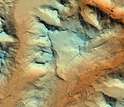News Release 16-101
NSF, NGA release first unclassified digital elevation models of Alaska
High-resolution maps, issued in support of White House Arctic initiative, will aid researchers in studying range of issues, including effects of climate change

A digital elevation model of the 425-mile-long Koyukuk River, a tributary of Alaska's Yukon River.
September 1, 2016
This material is available primarily for archival purposes. Telephone numbers or other contact information may be out of date; please see current contact information at media contacts.
The National Science Foundation (NSF) and the National Geospatial-Intelligence Agency (NGA) have publicly released new three-dimensional topographic maps of Alaska in support of a White House Arctic initiative to inform better decision-making in the Arctic.
The digital elevation models, or DEMs, are the first maps to be released by the ArcticDEM project, which was created after a January 2015 executive order calling for enhanced coordination of national efforts in the Arctic.
"To help Alaskans better plan for sustainable development, the National Geospatial-Intelligence Agency and the National Science Foundation are leading a public-private collaboration to create the first-ever publicly available, high-resolution, satellite-based elevation map of Alaska by next year and the entire Arctic by the year after that," said President Obama in remarks at Alaska's Kotzebue High School on Sept. 3, 2015.
Models of the entire Arctic are scheduled for release in 2017.
The models are based on stereo pairs of 2-meter resolution imagery captured by DigitalGlobe commercial satellites. Algorithms process the stereo pairs into three-dimensional imagery. This technology is significant in polar mapping because satellite imagery can be collected more regularly and across the entire Arctic compared to traditional imagery collection by aircraft, which is much more expensive and challenging to collect.
The ArcticDEM project is a collaboration of NSF- and NGA-supported researchers at the University of Minnesota's Polar Geospatial Center (PGC), as well as Ohio State University and Cornell University. NSF-supported advanced computing resources that assisted in the development of the DEMs include Blue Waters -- one of the most powerful supercomputers in the world -- at the University of Illinois at Urbana-Champaign, and the Extreme Science and Engineering Discovery Environment (XSEDE), a virtual system that enhances the productivity of and broadens participation among users of NSF-supported advanced computing and data platforms. PGC has processed all the imagery needed to generate tens of thousands of individual models.
The project brings together a unique set of national assets, which, aside from the grantee institutions, includes the U.S. Geological Survey and the state of Alaska.
"NSF is delighted that this partnership between the university community we support, NGA, USGS, the private sector and international counterparts has resulted in the innovation to deliver unprecedented digital elevation maps so critical to the Arctic at a time of profound change," NSF Director France Córdova said.
ArcticDEM products will allow for comparison of physical landscape features over time, enabling scientists to observe patterns of erosion, tectonic activity and other natural processes, some of which are accelerating as the Arctic warms. The completed maps will serve as a benchmark for researchers studying such features as glaciers and thermokarst -- depressions that develop in the landscape due to permafrost melting -- as well as the effects of wildfires.
"The models will play an important role in informing policy and national security decisions," said Robert Cardillo, NGA director. "They may also provide critical data and context for decisions related to climate resilience, land management, sustainable development, safe recreation and scientific research."
The release of high-resolution elevation maps marks a huge step forward in our ability to deal with the changing Arctic, said Ambassador Mark Brzezinski, executive director of the Arctic Executive Steering Committee at the White House.
"The Arctic region is experiencing some of the most rapid and profound changes in the world," said Brzezinski. "These changes impact communities, as well as the ecosystems upon which they depend. Yet, much of Alaska and the Arctic lack even basic modern and reliable maps to help Arctic communities understand and manage these risks. The DEMs will address this gap."
Teams from NGA and NSF worked with their partner institutions to launch an unclassified, open Arctic portal, where the DEMs and emerging information are available to the public. Esri, a geographic information system provider, hosts the site at nga.maps.arcgis.com. The public website provides Webmaps, map viewers, other DEM exploratory tools, nautical charts, sailing directions and infographics, as well as a downloadable Pan-Arctic map with mission-specific data layers.
The U.S. serves as the chair of the Arctic Council through Spring 2017, when the position will rotate to Finland for two years.
Because the U.S. is an Arctic nation, the White House Arctic initiative supports efforts to increase our understanding of the Arctic, engage with residents of the Arctic, and develop tools, products and services that improve federal, state and local activities in the Arctic.
-NSF-
-
Wolverine Glacier, a valley glacier in the mountains of south-central Alaska's Kenai Peninsula.
Credit and Larger Version
Media Contacts
Peter West, NSF, (703) 292-7530, email: pwest@nsf.gov
Principal Investigators
Paul Morin, Polar Geospatial Center, University of Minnesota, (612) 626-0505, email: lpaul@umn.edu
The U.S. National Science Foundation propels the nation forward by advancing fundamental research in all fields of science and engineering. NSF supports research and people by providing facilities, instruments and funding to support their ingenuity and sustain the U.S. as a global leader in research and innovation. With a fiscal year 2023 budget of $9.5 billion, NSF funds reach all 50 states through grants to nearly 2,000 colleges, universities and institutions. Each year, NSF receives more than 40,000 competitive proposals and makes about 11,000 new awards. Those awards include support for cooperative research with industry, Arctic and Antarctic research and operations, and U.S. participation in international scientific efforts.
Connect with us online
NSF website: nsf.gov
NSF News: nsf.gov/news
For News Media: nsf.gov/news/newsroom
Statistics: nsf.gov/statistics/
Awards database: nsf.gov/awardsearch/
Follow us on social
Twitter: twitter.com/NSF
Facebook: facebook.com/US.NSF
Instagram: instagram.com/nsfgov

